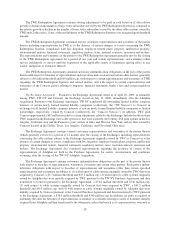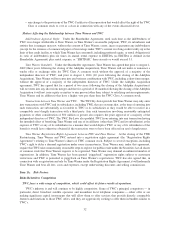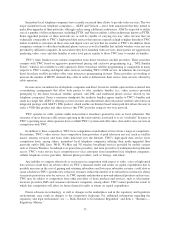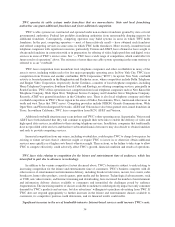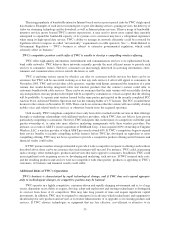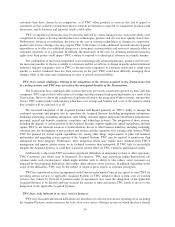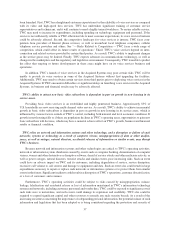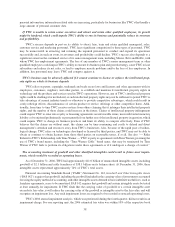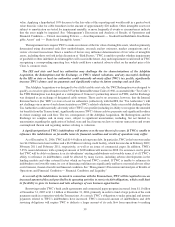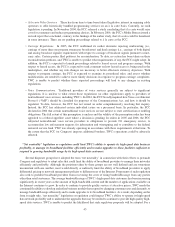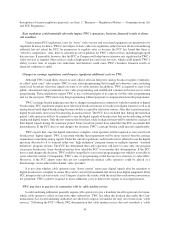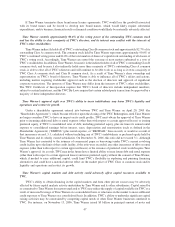Time Warner Cable 2006 Annual Report Download - page 43
Download and view the complete annual report
Please find page 43 of the 2006 Time Warner Cable annual report below. You can navigate through the pages in the report by either clicking on the pages listed below, or by using the keyword search tool below to find specific information within the annual report.personal information, information-related risks are increasing, particularly for businesses like TWC’s that handle a
large amount of personal customer data.
If TWC is unable to retain senior executives and attract and retain other qualified employees, its growth
might be hindered, which could impede TWC’s ability to run its business and potentially reduce its revenues
and profitability.
TWC’s success depends in part on its ability to attract, hire, train and retain qualified managerial, sales,
customer service and marketing personnel. TWC faces significant competition for these types of personnel. TWC
may be unsuccessful in attracting and retaining the required personnel to conduct and expand its operations
successfully and, in such an event, its revenues and profitability could decline. TWC’s success also depends to a
significant extent on the continued service of its senior management team, including Messrs. Britt and Hobbs, with
whom TWC has employment agreements. The loss of any member of TWC’s senior management team or other
qualified employees could impair TWC’s ability to execute its business plan and growth strategy, cause TWC to lose
subscribers and reduce its net sales, or lead to employee morale problems and/or the loss of key employees. In
addition, key personnel may leave TWC and compete against it.
TWC’s business may be adversely affected if it cannot continue to license or enforce the intellectual prop-
erty rights on which its business depends.
TWC relies on patent, copyright, trademark and trade secret laws and licenses and other agreements with its
employees, customers, suppliers, and other parties, to establish and maintain its intellectual property rights in
technology and the products and services used in TWC’s operations. However, any of TWC’s intellectual property
rights could be challenged or invalidated, or such intellectual property rights may not be sufficient to permit TWC to
take advantage of current industry trends or otherwise to provide competitive advantages, which could result in
costly redesign efforts, discontinuance of certain product or service offerings or other competitive harm. Addi-
tionally, from time to time TWC receives notices from others claiming that it infringes their intellectual property
rights, and the number of these claims could increase in the future. Claims of intellectual property infringement
could require TWC to enter into royalty or licensing agreements on unfavorable terms, incur substantial monetary
liability or be enjoined preliminarily or permanently from further use of the intellectual property in question, which
could require TWC to change its business practices and limit its ability to compete effectively. Even if TWC
believes that the claims are without merit, the claims can be time-consuming and costly to defend and divert
management’s attention and resources away from TWC’s businesses. Also, because of the rapid pace of techno-
logical change, TWC relies on technologies developed or licensed by third parties, and TWC may not be able to
obtain or continue to obtain licenses from these third parties on reasonable terms, if at all. See also “— Risks
Related to TWC’s Relationship with Time Warner — TWC is party to agreements with Time Warner governing the
use of TWC’s brand names, including the “Time Warner Cable” brand name, that may be terminated by Time
Warner if TWC fails to perform its obligations under those agreements or if it undergoes a change of control.”
The accounting treatment of goodwill and other identified intangibles could result in future asset impair-
ments, which would be recorded as operating losses.
As of December 31, 2006, TWC had approximately $41.0 billion of unamortized intangible assets, including
goodwill of $2.1 billion and cable franchises of $38.1 billion on its balance sheet. At December 31, 2006, these
intangible assets represented approximately 74% of TWC’s total assets.
Financial Accounting Standards Board (“FASB”) Statement No. 142, Goodwill and Other Intangible Assets
(“FAS 142”) requires that goodwill, including the goodwill included in the carrying value of investments accounted
for using the equity method of accounting, and other intangible assets deemed to have indefinite useful lives, such as
franchise agreements, cease to be amortized. FAS 142 requires that goodwill and certain intangible assets be tested
at least annually for impairment. If TWC finds that the carrying value of goodwill or a certain intangible asset
exceeds its fair value, it will reduce the carrying value of the goodwill or intangible asset to the fair value, and will
recognize an impairment loss. Any such impairment losses are required to be recorded as noncash operating losses.
TWC’s 2006 annual impairment analysis, which was performed during the fourth quarter, did not result in an
impairment charge. For one reporting unit, the 2006 estimated fair value was within 10% of the respective book
38


